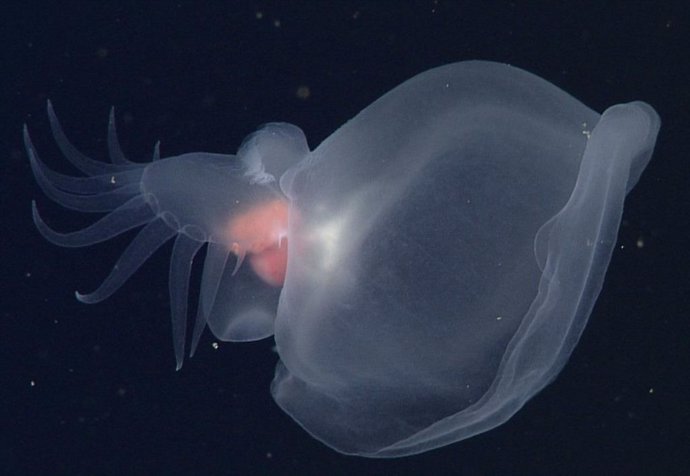Nov. 12 () –
Researchers of the MBARI (Monterey Bay Aquarium Research Institute) have discovered a surprising new species of sea slug that lives in ocean depths of up to 4,000 meters.
Bathydevius caudactylus swims through the ocean’s ‘midnight zone’ with a large gelatinous hood and paddle-shaped tail, and lights up with brilliant bioluminescence. The team published a description of the animal, dubbed the “mystery mollusk,” in the journal Deep-Sea Research Part I.
“Thanks to MBARI’s advanced underwater technology, we were able to prepare the most complete description of a deep-sea animal ever made. We have spent more than 20 years understanding the natural history of this fascinating species of nudibranch. Our discovery is a new piece of the puzzle that can help better understand the largest habitat on Earth,” said in a statement MBARI senior scientist Bruce Robison, who led efforts to describe the mysterious mollusk.
MBARI researchers They first observed the mysterious mollusk in February 2000 during a remotely operated vehicle (ROV) dive offshore Monterey Bay at a depth of 2,614 meters. The team has collected extensive information on the natural history of the mysterious mollusk. After reviewing more than 150 sightings from MBARI ROVs over the past 20 years, they published a detailed description of this animal.
With a bulky, hooded structure on one end, a flat tail lined with numerous finger-like projections on the other, and colorful internal organs in the middle, the team initially had difficulty placing this animal in a group. Because the animal also had a foot like a snail, They nicknamed him the “mysterious mollusk.”
After carefully collecting a specimen, MBARI researchers were able to take a closer look at the animal in the laboratory. Through detailed investigations of anatomy and genetics, they began to solve the mystery, and they finally confirmed that this incredible animal is a nudibranch.
Most nudibranchs, also known as sea slugs, live on the sea floor. Nudibranchs are common in coastal environments, including tide pools, kelp forests, and coral reefs, and a small number of species are known to live on the abyssal seafloor. A few are pelagic and live in open water near the surface.
The mysterious mollusk is the first nudibranch known to live in the deep water column. This species lives in the midnight zone of the ocean, an expansive open water environment 1,000 to 4,000 meters below the surface, also known as the bathypelagic zone.
The mystery mollusk is now known to live in the Pacific coastal waters of North America, and has been seen on MBARI expeditions as far north as Oregon and as far south as Southern California. An observation of a similar-looking animal by NOAA researchers in the Mariana Trench in the western Pacific suggests the mystery mollusk may have a broader distribution.
The mysterious mollusk has developed unique solutions to find food, safety and companions to survive in the midnight zone.
While most sea slugs use a rough tongue to feed on prey attached to the seafloor, the mystery mollusk uses a cavernous hood to trap crustaceans like a Venus flytrap plant. Several other unrelated deep-sea species use this feeding strategy, including some jellyfish, anemones, and tunicates.
Mysterious mollusks are often seen in open waters far below the surface and far above the seafloor. They move through these waters by flexing their body up and down to swim or simply floating motionless with the currents. To avoid being eaten, the mysterious mollusk hides in plain sight with a transparent body. Quickly closing the oral hood facilitates rapid escape, similar to the pulse of a jellyfish’s bell.
If it feels threatened, the mysterious mollusk can light up with bioluminescence to deter and distract hungry predators. On one occasion, researchers observed the animal light up and then detach a constantly glowing finger-like projection from its tail, likely serving as a decoy to distract a potential predator.
Like other nudibranchs, the mysterious mollusk is hermaphrodite and has male and female sexual organs. The mysterious mollusk appears to descend to the seabed to spawn. The MBARI researchers observed that Some animals used their muscular foot to cling to the muddy seafloor in order to release their eggs.
A detailed examination of specific genetic sequences confirmed that the mysterious mollusk is unique enough from other known nudibranchs to merit the creation of a new family, Bathydeviidae.














![[Img #74661]](https://thelatestnews.world/wp-content/uploads/2024/12/The-power-of-ultrasound-300x200.jpg)
Add Comment